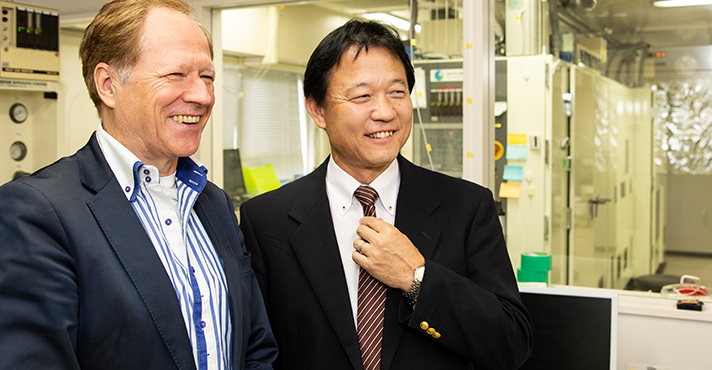
Professor Yasufumi Fujiwara, Division of Material and Manufacturing Science, Graduate School of Engineering
"A shocking discovery comes to light! Property found in crystals provides efficient method for converting light into electricity"
An international joint research team led by Dr. Yasufumi Fujiwara recently published an article entitled “Efficient carrier multiplication in CsPbI3 perovskite nanocrystals” in Nature Communications . The team has shown that certain perovskites in fact do have this desirable property.

Professor Yasufumi Fujiwara, Graduate School of Engineering
1. What makes this research so interesting?
Perovskites – named after 19th century Russian mineralogist Lev Perovski – form a particular family of materials that all share the same crystal structure. These perovskites have many desirable electronic properties, making some of them useful for applications in LEDs, TV screens, solar cells and lasers. Therefore, perovskites have been studied extensively by physicists in recent years.
A property which previously had not been shown to exist in perovskites is carrier multiplication. When semiconductors – in photodetectors or solar cells, for example – convert the energy of light into electricity, this is usually done one particle at a time: a single absorbed photon generates a single excited electron (and the corresponding “hole” where the electron used to be) that can carry an electrical current.
However, in certain nanomaterials, a single photon of high energy can generate not one but two or even more electron-hole pairs; this process is known as carrier multiplication. When carrier multiplication occurs, the conversion from light into electricity becomes much more efficient while limiting detrimental heat dissipation.
For example, in ordinary solar cells, there is a theoretical limit (the so-called Shockley-Queisser limit) on the amount of energy that can be converted: at most, a little over 33% of the solar energy gets converted into electrical power. Using semiconductor nanocrystals that feature the carrier multiplication effect, however, a maximum efficiency of up to 44% is predicted for solar cells where carrier multiplication would be explored to its maximum capacity.
Our recent research identifies inorganic perovskite nanocrystals and nanolayers as promising candidates for the next generation of highly efficient, thin, and mechanically flexible solar cells.
2. This new research was performed in collaboration with the University of Amsterdam led by Prof. Dr. Tom Gregorkiewicz. What is the attractiveness of international collaborative research?

Their determination. The team places a lot of emphasis on external visibility and popularization of their results, so they invest a great deal of effort into publishing their work in the best international journals with the highest possible impact factor. For this purpose, we discussed experimental results at length from various points of view. The long and intense discussion was carried out by the whole team in front of a white board. During the discussion, participants were not permitted to keep silent, and clear statements were required from everyone. While this method of discussion is sometimes quite different from the traditional Japanese approach, it is the global standard, making it a valuable experience for our students.
For this international collaborative research, several members of Tom’s group visited my laboratory and stayed for an extended period. At first, my students were hesitant to interact and talk with them in English. However, after a short time, they learned that, although their level of English is not perfect, it is nevertheless perfectly sufficient for easy communication – both on scientific and everyday topics. I hope they cherish this realization, as I’m sure it will give them a great deal of confidence in their professional careers.
For more information:
http://www.dma.jim.osaka-u.ac.jp/view?l=en&u=6632
https://www.researchgate.net/profile/Yasufumi_Fujiwara
Text: Saori Obayashi/Edit: Christopher Bubb